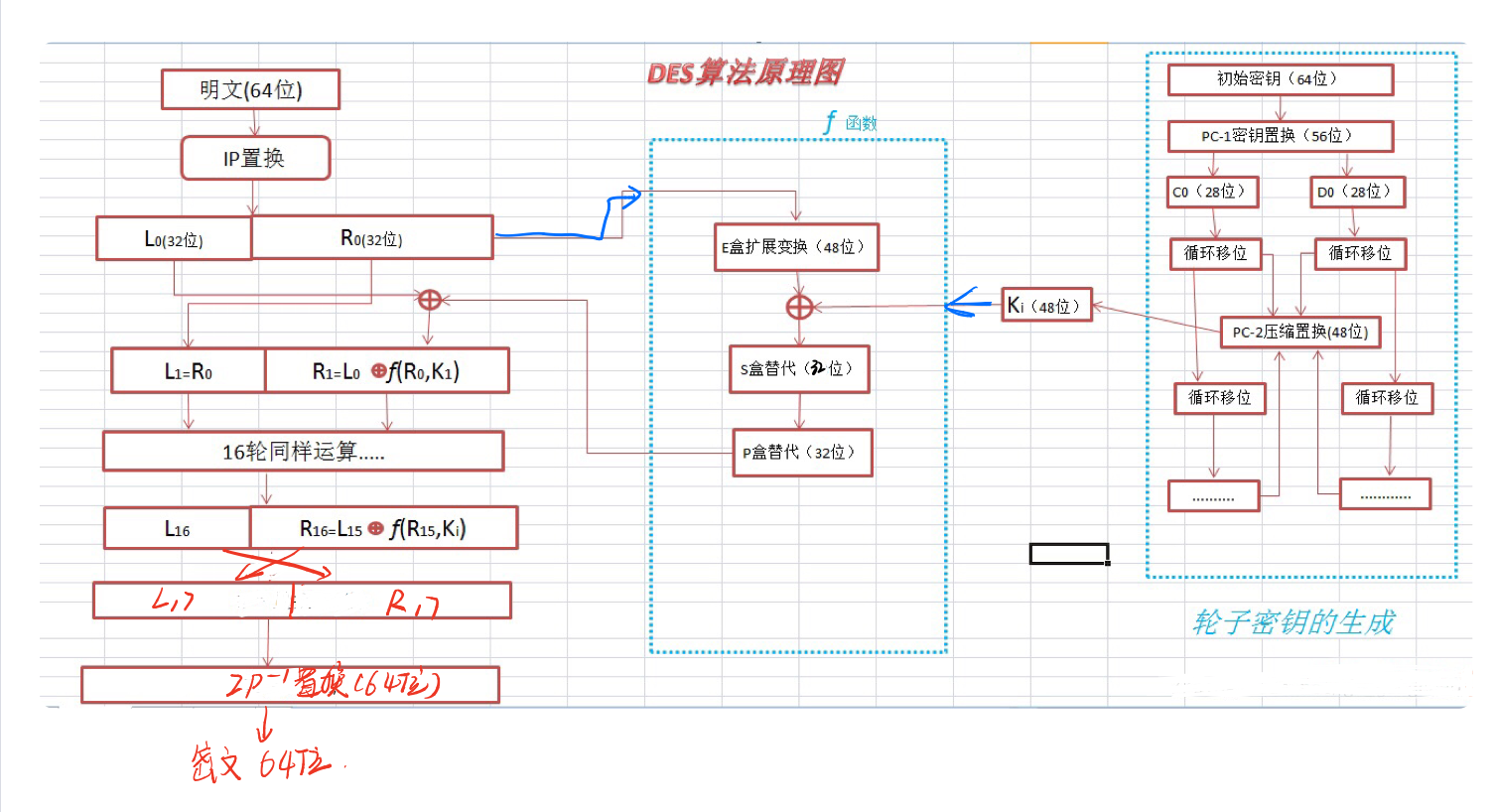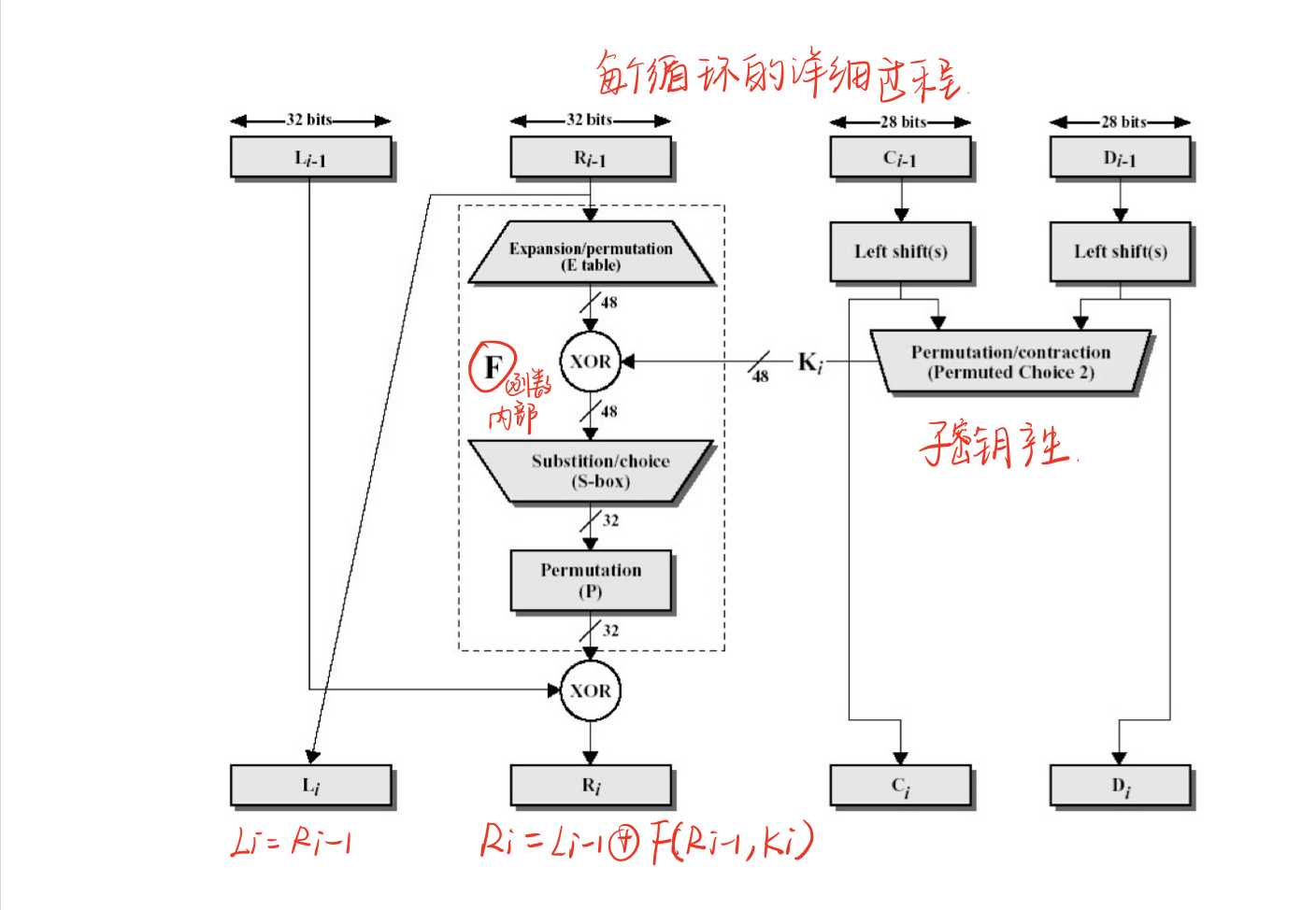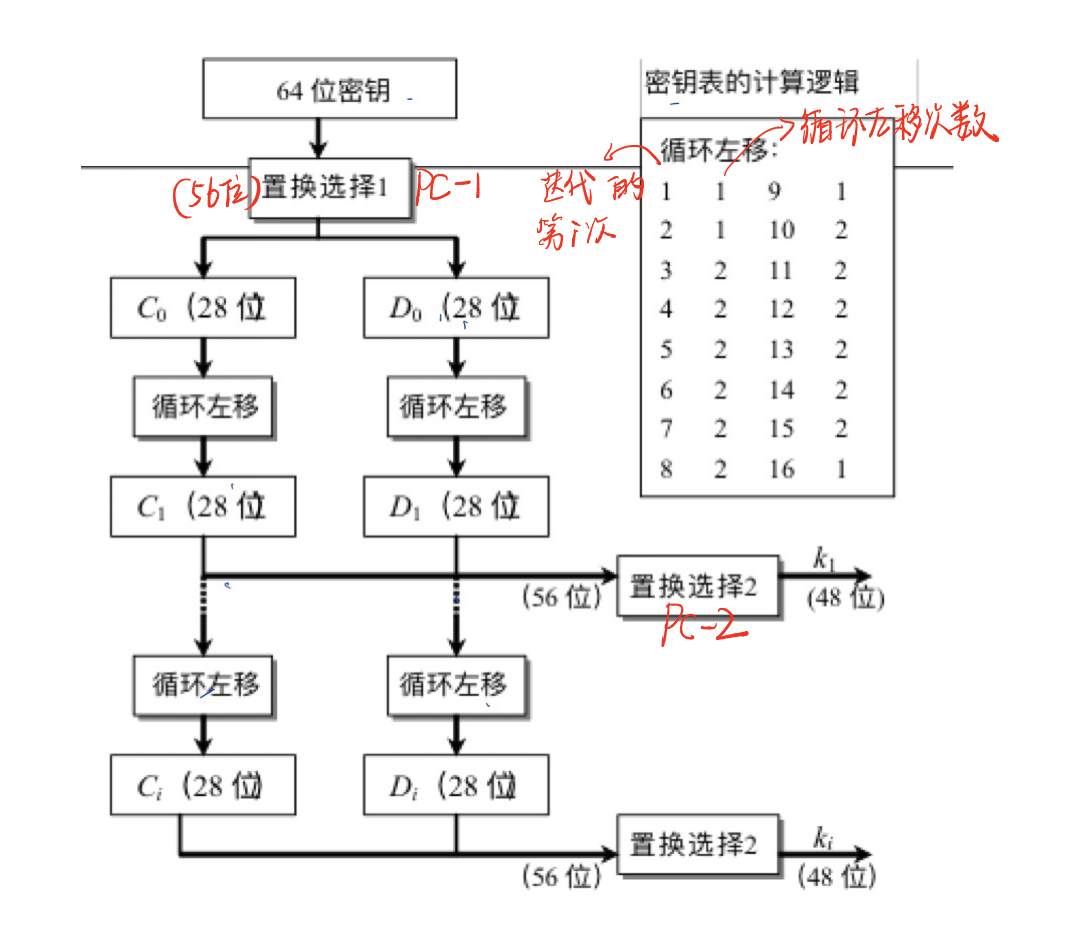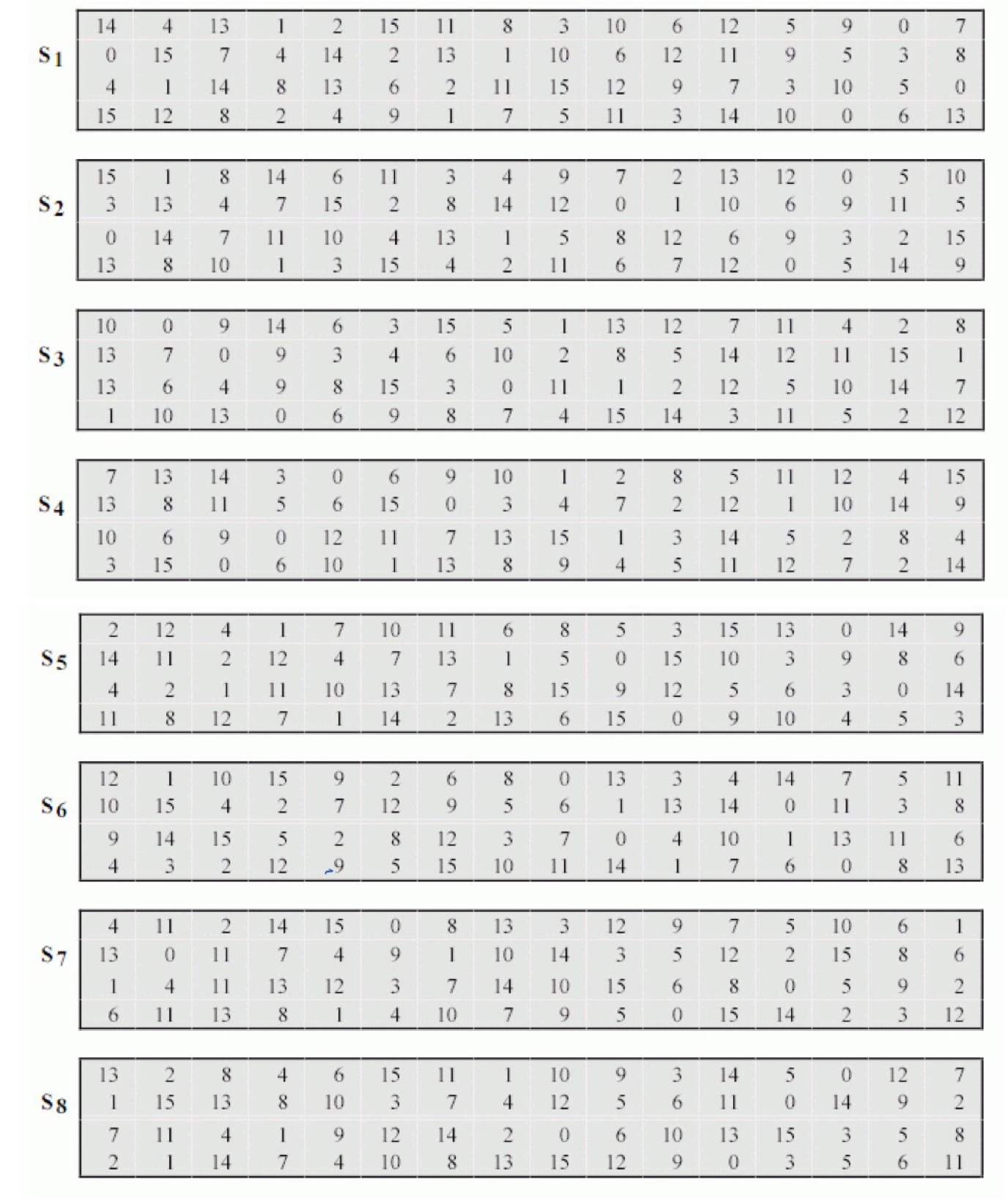DES
DES全称为Data Encryption Standard,即数据加密标准,是一种使用密钥加密的块算法,1977年被美国联邦政府的国家标准局确定为联邦资料处理标准(FIPS),并授权在非密级政府通信中使用,随后该算法在国际上广泛流传开来。
设计原则
DES设计中使用了分组密码设计的两个原则:混淆(confusion)和扩散(diffusion),其目的是抗击敌手对密码系统的统计分析。
混淆是使密文的统计特性与密钥的取值之间的关系尽可能复杂化,以使密钥和明文以及密文之间的依赖性对密码分析者来说是无法利用的。
扩散的作用就是将每一位明文的影响尽可能迅速地作用到较多的输出密文位中,以便在大量的密文中消除明文的统计结构,并且使每一位密钥的影响尽可能迅速地扩展到较多的密文位中,以防对密钥进行逐段破译。
入门体验
java 实现
import javax.crypto.*;
import javax.crypto.spec.DESKeySpec;
import java.io.UnsupportedEncodingException;
import java.security.InvalidKeyException;
import java.security.NoSuchAlgorithmException;
import java.security.SecureRandom;
import java.security.spec.InvalidKeySpecException;
/**
* DES 工具类
*
* @author binbin.hou
* @since 0.0.6
*/
public final class DesUtil {
private DesUtil() {
}
/**
* des
*
* @since 0.0.6
*/
private static final String DES = "DES";
/**
* 加密
*
* @param plainText 待加密内容
* @param password 密码
* @return 加密结果
* @since 0.0.6
*/
public static byte[] encrypt(String plainText, String password) {
byte[] bytes = plainText.getBytes();
return encrypt(bytes, password);
}
/**
* 加密
*
* @param plainText 待加密内容
* @param password 密码
* @return 加密结果
* @since 0.0.6
*/
public static byte[] encrypt(byte[] plainText, String password) {
try {
SecureRandom random = new SecureRandom();
DESKeySpec desKey = new DESKeySpec(password.getBytes());
// 创建一个密匙工厂,然后用它把DESKeySpec转换成
SecretKeyFactory keyFactory = SecretKeyFactory.getInstance(DES);
SecretKey secretKey = keyFactory.generateSecret(desKey);
// Cipher对象实际完成加密操作
Cipher cipher = Cipher.getInstance(DES);
// 用密匙初始化Cipher对象
cipher.init(Cipher.ENCRYPT_MODE, secretKey, random);
// 现在,获取数据并加密
// 正式执行加密操作
return cipher.doFinal(plainText);
} catch (Exception e) {
throw new SecretRuntimeException(e);
}
}
/**
* 解密
*
* @param src byte[]
* @param password String
* @return 解密结果
* @since 0.0.6
*/
public static byte[] decrypt(byte[] src, String password) {
try {
// DES算法要求有一个可信任的随机数源
SecureRandom random = new SecureRandom();
// 创建一个DESKeySpec对象
DESKeySpec desKey = new DESKeySpec(password.getBytes());
// 创建一个密匙工厂
SecretKeyFactory keyFactory = SecretKeyFactory.getInstance(DES);
// 将DESKeySpec对象转换成SecretKey对象
SecretKey secretKey = keyFactory.generateSecret(desKey);
// Cipher对象实际完成解密操作
Cipher cipher = Cipher.getInstance(DES);
// 用密匙初始化Cipher对象
cipher.init(Cipher.DECRYPT_MODE, secretKey, random);
// 真正开始解密操作
return cipher.doFinal(src);
} catch (InvalidKeyException | NoSuchAlgorithmException | InvalidKeySpecException | NoSuchPaddingException | IllegalBlockSizeException | BadPaddingException e) {
throw new SecretRuntimeException(e);
}
}
/**
* 解密
*
* @param src byte[]
* @param password String
* @return 解密结果
* @since 0.0.6
*/
public static String decryptToString(byte[] src, String password,
String charset) {
try {
byte[] bytes = decrypt(src, password);
return new String(bytes, charset);
} catch (UnsupportedEncodingException e) {
throw new SecretRuntimeException(e);
}
}
/**
* 解密
*
* @param src byte[]
* @param password String
* @return 解密结果
* @since 0.0.6
*/
public static String decryptToString(byte[] src, String password) {
return decryptToString(src, password, "UTF-8");
}
}
测试代码
测试代码如下:
public static void main(String[] args) {
// 待加密内容
String str = "测试内容";
// 密码,长度要是8的倍数
String password = "01234567";
byte[] result = DesUtil.encrypt(str, password);
System.out.println("加密后:" + HexUtil.byteToHexString(result));
// 直接将如上内容解密
String decryResult = DesUtil.decryptToString(result, password);
System.out.println("解密后:" + decryResult);
}
日志如下:
加密后:77C25C0143F544CFFF102E43BDE1ABE1
解密后:测试内容
算法原理
DES算法会对明文进行16轮的迭代加密,具体的算法过程可以看下面这图。

下面这张图是每次迭代的的一个提取,我们从中可以直接观察到的就是迭代的两个规律:
Li = Ri-1
Ri = Li-1 ^ F(Ri-1, Ki)
上一轮的输出作为下一轮加密的输入(也就是迭代的过程)。
同样,子密钥也是迭代产生。

在总体概览了一遍后,我们可以将DES算法分为3部分来讲解。
从第一张图从右往左,轮子密钥(子密钥)的生成、F函数的实现以及16次迭代的过程。
子密钥的产生

如图上的流程图所示,将所给的初始64位密钥(若是密钥不足64位则前面加0补充至64位),经过PC-1置换压缩成56位。
然后分成左右28位,表示成C0, D0。
C0和D0按照循环左移表来分别循环左移,此处是第一次循环,所以循环左移1次,生成C1和D1。
然后C1和D1合并成56位密钥经过PC-2置换压缩成48位的K1。
K2的生成过程:C1和D1分别循环左移1次,然后合并经过PC-2置换压缩成K2。Ki的生成就为Ci-1和Di-1分别循环左移,然后合并经过PC-2置换压缩而成。
- PC-1 置换表 PC-2置换表 循环左移表
//PC-1置换表
private int[] PC1={
57,49,41,33,25,17,9,
1,58,50,42,34,26,18,
10,2,59,51,43,35,27,
19,11,3,60,52,44,36,
63,55,47,39,31,23,15,
7,62,54,46,38,30,22,
14,6,61,53,45,37,29,
21,13,5,28,20,12,4};
//PC-2置换表
private int[] PC2={
14,17,11,24,1,5,3,28,
15,6,21,10,23,19,12,4,
26,8,16,7,27,20,13,2,
41,52,31,37,47,55,30,40,
51,45,33,48,44,49,39,56,
34,53,46,42,50,36,29,32};
//循环左移次数表
private int[] leftTable = {1,1,2,2,2,2,2,2,1,2,2,2,2,2,2,1};
F函数的原理
F函数的内部还是比较复杂,不过问题不大。我们按照F函数内部执行顺序来可以分为以下几步:
-
Ri-1做一个E扩展,从32位扩展成48位
-
Ri-1与Ki异或运算,然后将异或运算的结果经过S盒选择压缩成32位
-
从S盒出来的32位结果再经过P置换,就得到最终的32位Ri
Ri-1做扩散选择的表如下:
//E扩展
private int[] ETable = {
32,1,2,3,4,5,
4,5,6,7,8,9,
8,9,10,11,12,13,
12,13,14,15,16,17,
16,17,18,19,20,21,
20,21,22,23,24,25,
24,25,26,27,28,29,
28,29,30,31,32,1};
从S盒出来的32位结果经过的P表如下:
//P置换
private int[] P={
16,7,20,21,29,12,28,17,
1,15,23,26,5,18,31,10,
2,8,24,14,32,27,3,9,
19,13,30,6,22,11,4,25};
在这三步中最为机密的就是S盒的选择压缩了。
S盒是如何实现选择压缩呢?
我们就要知道S的结构了。
- S盒的结构

我们可以看出,进入S盒后将Ri-1与Ki异或的值分成8组,每组6位,分别进入S1-S8盒,然后从每个盒中出4位,合并成32位的结果。
若是还想探究6位变成4位是如何的变换的,就需要看下面这点介绍:

我们以进入S!盒为例,假设进入的6位二进制数为101001,我们一般将第一位和最后一位(从左到右)作为行坐标,中间四位作为纵坐标找值。
11即3行,0100即4列(从0开始编号),最后选出的值就为4,四位二进制表示则为0100。
16 次的迭代加密
最初我们需要将初始的明文做一个IP置换,然后分成左右各32位即L0 R0,带入L0、R0去计算L1和R1。
16 次迭代的规律为:
Li = Ri-1
Ri = Li-1 ^ F(Ri-1, Ki)
最后,L16与R16直接交换赋给L17和R17(L17=R16, R17=L16),然后L17与R17合并后通过IP逆置换生成最终的密文。
以上,便是加密过程,解密可以说是加密的逆向过程。
解密为何反向就可以解密,还需要各位看官另觅资料~
完整的 java 实现
/**
* @description: 代码实现Des算法加解密
* @author sakura
* @date 2019年3月25日 下午12:52:21
*/
/*
* 1.主要的一个迭代公式 Li=Ri Ri = Li-1 ⊕F(Li-1,Ki)
* 2.整体可以分为 加解密运算 F函数的处理 子密钥的产生
* 3.子秘钥产生:64位经过PC-1密钥置换成56位 分为Ci Di左右各28为位 然后根据循环左移表来左移 最后经过PC-2置换成48位的密钥Ki
* 4.F函数的处理:Li-1(32位)经过E盒扩展成48位; 48位的Li-1与 子秘钥Ki进行异或 ;
* 异或的结果经过S盒(8个盒子 6进4出)生成32位;32位再经过P盒转换成最后32位F函数处理后的结果
* 5.加解密运算这边:先将明文做一个IP置换,然后将64位分成左右32位L0,R0 然后开始迭代 ;到第16次,做IP逆置换生成最终的密文
*
* 6.解密运算:
* 加密反过来
*
*/
public class DES {
//初始IP置换
private int[] IP={
58,50,42,34,26,18,10,2,
60,52,44,36,28,20,12,4,
62,54,46,38,30,22,14,6,
64,56,48,40,32,24,16,8,
57,49,41,33,25,17,9,1,
59,51,43,35,27,19,11,3,
61,53,45,37,29,21,13,5,
63,55,47,39,31,23,15,7};
//IP逆置换
private int[] IP1={
40,8,48,16,56,24,64,32,
39,7,47,15,55,23,63,31,
38,6,46,14,54,22,62,30,
37,5,45,13,53,21,61,29,
36,4,44,12,52,20,60,28,
35,3,43,11,51,19,59,27,
34,2,42,10,50,18,58,26,
33,1,41,9,49,17,57,25};
//E扩展
private int[] ETable={
32,1,2,3,4,5,
4,5,6,7,8,9,
8,9,10,11,12,13,
12,13,14,15,16,17,
16,17,18,19,20,21,
20,21,22,23,24,25,
24,25,26,27,28,29,
28,29,30,31,32,1};
//P置换
private int[] P={
16,7,20,21,29,12,28,17,
1,15,23,26,5,18,31,10,
2,8,24,14,32,27,3,9,
19,13,30,6,22,11,4,25};
//S盒
private static final int[][][] SBox = {
{
{ 14, 4, 13, 1, 2, 15, 11, 8, 3, 10, 6, 12, 5, 9, 0, 7 },
{ 0, 15, 7, 4, 14, 2, 13, 1, 10, 6, 12, 11, 9, 5, 3, 8 },
{ 4, 1, 14, 8, 13, 6, 2, 11, 15, 12, 9, 7, 3, 10, 5, 0 },
{ 15, 12, 8, 2, 4, 9, 1, 7, 5, 11, 3, 14, 10, 0, 6, 13 } },
{
{ 15, 1, 8, 14, 6, 11, 3, 4, 9, 7, 2, 13, 12, 0, 5, 10 },
{ 3, 13, 4, 7, 15, 2, 8, 14, 12, 0, 1, 10, 6, 9, 11, 5 },
{ 0, 14, 7, 11, 10, 4, 13, 1, 5, 8, 12, 6, 9, 3, 2, 15 },
{ 13, 8, 10, 1, 3, 15, 4, 2, 11, 6, 7, 12, 0, 5, 14, 9 } },
{
{ 10, 0, 9, 14, 6, 3, 15, 5, 1, 13, 12, 7, 11, 4, 2, 8 },
{ 13, 7, 0, 9, 3, 4, 6, 10, 2, 8, 5, 14, 12, 11, 15, 1 },
{ 13, 6, 4, 9, 8, 15, 3, 0, 11, 1, 2, 12, 5, 10, 14, 7 },
{ 1, 10, 13, 0, 6, 9, 8, 7, 4, 15, 14, 3, 11, 5, 2, 12 } },
{
{ 7, 13, 14, 3, 0, 6, 9, 10, 1, 2, 8, 5, 11, 12, 4, 15 },
{ 13, 8, 11, 5, 6, 15, 0, 3, 4, 7, 2, 12, 1, 10, 14, 9 },
{ 10, 6, 9, 0, 12, 11, 7, 13, 15, 1, 3, 14, 5, 2, 8, 4 },
{ 3, 15, 0, 6, 10, 1, 13, 8, 9, 4, 5, 11, 12, 7, 2, 14 } },
{
{ 2, 12, 4, 1, 7, 10, 11, 6, 8, 5, 3, 15, 13, 0, 14, 9 },
{ 14, 11, 2, 12, 4, 7, 13, 1, 5, 0, 15, 10, 3, 9, 8, 6 },
{ 4, 2, 1, 11, 10, 13, 7, 8, 15, 9, 12, 5, 6, 3, 0, 14 },
{ 11, 8, 12, 7, 1, 14, 2, 13, 6, 15, 0, 9, 10, 4, 5, 3 } },
{
{ 12, 1, 10, 15, 9, 2, 6, 8, 0, 13, 3, 4, 14, 7, 5, 11 },
{ 10, 15, 4, 2, 7, 12, 9, 5, 6, 1, 13, 14, 0, 11, 3, 8 },
{ 9, 14, 15, 5, 2, 8, 12, 3, 7, 0, 4, 10, 1, 13, 11, 6 },
{ 4, 3, 2, 12, 9, 5, 15, 10, 11, 14, 1, 7, 6, 0, 8, 13 } },
{
{ 4, 11, 2, 14, 15, 0, 8, 13, 3, 12, 9, 7, 5, 10, 6, 1 },
{ 13, 0, 11, 7, 4, 9, 1, 10, 14, 3, 5, 12, 2, 15, 8, 6 },
{ 1, 4, 11, 13, 12, 3, 7, 14, 10, 15, 6, 8, 0, 5, 9, 2 },
{ 6, 11, 13, 8, 1, 4, 10, 7, 9, 5, 0, 15, 14, 2, 3, 12 } },
{
{ 13, 2, 8, 4, 6, 15, 11, 1, 10, 9, 3, 14, 5, 0, 12, 7 },
{ 1, 15, 13, 8, 10, 3, 7, 4, 12, 5, 6, 11, 0, 14, 9, 2 },
{ 7, 11, 4, 1, 9, 12, 14, 2, 0, 6, 10, 13, 15, 3, 5, 8 },
{ 2, 1, 14, 7, 4, 10, 8, 13, 15, 12, 9, 0, 3, 5, 6, 11 } }
};
//PC-1置换表
private int[] PC1={
57,49,41,33,25,17,9,
1,58,50,42,34,26,18,
10,2,59,51,43,35,27,
19,11,3,60,52,44,36,
63,55,47,39,31,23,15,
7,62,54,46,38,30,22,
14,6,61,53,45,37,29,
21,13,5,28,20,12,4};
//PC-2置换表
private int[] PC2={
14,17,11,24,1,5,3,28,
15,6,21,10,23,19,12,4,
26,8,16,7,27,20,13,2,
41,52,31,37,47,55,30,40,
51,45,33,48,44,49,39,56,
34,53,46,42,50,36,29,32};
//循环左移次数表
private int[] leftTable = {1,1,2,2,2,2,2,2,1,2,2,2,2,2,2,1};
//加密轮数16轮
private static final int LOOP = 16;
private String[] keys = new String[LOOP];
private String[] pContent;
private String[] cContent;
private int originLength; //初始明文长度
//16个子密钥
private int[][] subKey = new int[16][48]; //存储16次的子密钥
private String content;
private int pOriginLegth; //明文初始长度?
//构造函数
public DES(String key, String content) {
this.content = content;
pOriginLegth = content.getBytes().length;
generateSubKey(key);
}
//主函数入口
public static void main(String[] args) {
String plainText = "SakuraOne";
System.out.println("明文: \n" + plainText);
String key = "IAMKEY";
DES des = new DES(key,plainText);
byte[] c = des.group(plainText.getBytes(), true);//加密
System.out.println("密文:\n" + new String(c));
byte[] p = des.group(c, false); //解密
byte[] pd = new byte[plainText.getBytes().length];
System.arraycopy(p, 0, pd, 0, plainText.getBytes().length);
System.out.println("解密后的明文:\n" + new String(pd));
}
/**
*拆分分组
*/
public byte[] group(byte[] plainText, boolean decryption) {
//填充明文长度为64位的整数
originLength = plainText.length;
int gNum;
int rNum;
gNum = originLength/8;
rNum = 8-(originLength-gNum*8);
byte[] pPadding;
if(rNum<8) {
pPadding = new byte[originLength+rNum];
System.arraycopy(plainText, 0, pPadding, 0, originLength);
for(int i=0; i<rNum; i++) {
pPadding[originLength+1]=(byte)rNum;
}
}else {
pPadding = plainText;
}
gNum = pPadding.length/8;
byte[] groupPT = new byte[8]; //64位分组单位
byte[] resultData = new byte[pPadding.length];
for(int i=0; i<gNum; i++) {
System.arraycopy(pPadding, i*8, groupPT, 0, 8);
System.arraycopy(encryptUnit(groupPT, subKey, decryption), 0, resultData, i*8, 8);
}
//如果是解密 这里感觉什么也没有做呢??
if(decryption == false) {
byte[] pResultData = new byte[pOriginLegth];
System.arraycopy(resultData, 0, pResultData, 0, pOriginLegth);
return pResultData;
}
return resultData;
}
/**
*加密一个64位分组
*
*/
public byte[] encryptUnit(byte[]unit, int keysArray[][], boolean decryption) {
//得到明文的01字符串
StringBuilder sb = new StringBuilder();
for(int i=0; i<8; i++) {
String tmpBit = Integer.toBinaryString(unit[i] & 0xff);
while(tmpBit.length()%8!=0) {
tmpBit="0"+tmpBit;
}
sb.append(tmpBit);
}
//将明文01字符串转换为数字01存放在数组中
int[] pBit = new int[64];
String pStr = sb.toString();
for(int i=0; i<64; i++) {
int bit = Integer.valueOf(pStr.charAt(i));
if(bit == 48) {
bit = 0;
}else if(bit == 49){
bit = 1;
}else {
System.out.println("To bit error");
}
pBit[i] = bit;
}
/*=========IP置换==========*/
int[] pIP = new int[64];
for(int i=0; i<64; i++) {
pIP[i] = pBit[IP[i]-1];
}
//加密
if(decryption) {
//迭代16次
for(int i=0; i<16; i++) {
loop(pIP, i, decryption, keysArray[i]);
}
}else { //解密 反向迭代
for(int i=15; i>-1; i--) {
loop(pIP, i, decryption, keysArray[i]);
}
}
/*===========IP逆置换=============*/
int[] c = new int[64];
for(int i=0; i<IP1.length; i++) {
c[i] = pIP[IP1[i]-1];
}
byte[] cByte = new byte[8];
for(int i=0; i<8; i++) {
cByte[i] = (byte)((c[8*i]<<7)+(c[8*i+1]<<6)+(c[8*i+2]<<5)+(c[8*i+3]<<4)+(c[8*i+4]<<3)+(c[8*i+5]<<2)+(c[8*i+6]<<1)+(c[8*i+7]));
}
return cByte; //最终的密码字节数组
}
//依次迭代过程
public void loop(int[] median, int times, boolean decryption, int[]keyArray ) {
int[] l0 = new int[32];
int[] r0 = new int[32];
int[] l1 = new int[32];
int[] r1 = new int[32];
int[] f = new int[32]; //调用F函数后生成的结果
System.arraycopy(median, 0, l0, 0, 32);
System.arraycopy(median, 32, r0, 0, 32);
l1 = r0;
f = fFunction(r0, keyArray); //调用F函数
for(int i=0; i<32; i++) {
r1[i] = l0[i]^f[i]; //ri = li-1 ^ f[i]
if(((decryption==false) && (times==0)) || ((decryption==true) && (times==15))) {
median[i] = r1[i];
median[i+32] = l1[i];
}else {
median[i] = l1[i];
median[i+32] = r1[i];
}
}
}
/**
* F函数
*/
public int[] fFunction(int[] rContent, int[] key) {
int[] result = new int[32];
int[] rXORkey = new int[48];
//ri扩展 与 keyi异或
for(int i=0; i<ETable.length; i++) {
rXORkey[i] = rContent[ETable[i]-1]^key[i];
}
/*=============S-box替换 将48位变成32位==============*/
int[][] s= new int[8][6];
int[] sAfter = new int[32];
for(int i=0; i<8; i++) {
System.arraycopy(rXORkey, i*6, s[i], 0, 6);
int r = (s[i][0]<<1)+s[i][5]; //横坐标
int c = (s[i][1]<<3) + (s[i][2]<<2) + (s[i][1]<<1) + s[i][4]; //纵坐标
String str = Integer.toBinaryString(SBox[i][r][c]);
while(str.length() < 4) {
str = "0"+str;
}
for(int j=0; j<4; j++) {
int p=Integer.valueOf(str.charAt(j));
if(p==48) {
p=0;
}else if(p==49) {
p=1;
}else {
System.out.println("To bit error!");
}
sAfter[4*i+j] = p;
}
}
/*===============P盒替换=====================*/
for(int i=0; i<P.length; i++) {
result[i] = sAfter[P[i]-1];
}
return result;
}
/**
* description:生成子密钥
*
* @param key 密钥
*
*/
public void generateSubKey(String key) {
//当key的长度小于64位时要扩展至64位
while(key.length()<8) {
key = key + key;
}
key = key.substring(0, 8);
//将字符密钥转换成二进制形式
byte[] keys = key.getBytes();
int[] kBit = new int[64];
for(int i=0; i<8; i++) {
//每个字节即每8位&0000 0000
String kStr = Integer.toBinaryString(keys[i] & 0xff);
//补齐8位
if(kStr.length()<8) {
for(int t=0; t<8-kStr.length(); t++) {
kStr = "0" + kStr;
}
}
//将01字符串转换成二进制01
for(int j=0; j<8; j++) {
int p = Integer.valueOf(kStr.charAt(j));
if(p == 48) {
p=0;
}else if(p == 49) {
p=1;
}else {
System.out.println("To bit error!");
}
kBit[i*8+j] = p;
}
}
//得到kBit 初始化的64位密钥 然后进行PC-1压缩成56位
/*==============PC-1压缩===============*/
int[] kNewBit = new int[56];
for(int i=0; i<PC1.length; i++) {
kNewBit[i] = kBit[PC1[i]-1];
}
/*================初始密钥分组=============*/
int[] c0 = new int[28];
int[] d0 = new int[28];
System.arraycopy(kNewBit, 0, c0, 0, 28);
System.arraycopy(kNewBit, 28, d0, 0, 28);
//生成16个子密钥
for(int i=0; i<16; i++) {
int[] c1 = new int[28];
int[] d1 = new int[28];
/*============ci、di分别循环左移===========*/
if(leftTable[i] == 1) {
System.arraycopy(c0, 1, c1, 0, 27);
c1[27]=c0[0];
System.arraycopy(d0, 1, d1, 0, 27);
d1[27]=d0[0];
}else if(leftTable[i] == 2) {
System.arraycopy(c0, 2, c1, 0, 26);
c1[26]=c0[0];
c1[27]=c0[1];
System.arraycopy(d0, 2, d1, 0, 26);
d1[26]=d0[0];
d1[27]=d0[1];
}else {
System.out.println("leftTable error!");
}
/*================ci、di合并 PC-2压缩置换=============*/
int[] tmp = new int[56];
System.arraycopy(c1, 0, tmp, 0, 28);
System.arraycopy(d1, 0, tmp, 28, 28);
for(int j=0; j<PC2.length; j++) {
subKey[i][j] = tmp[PC2[j]-1];
}
c0 = c1;
d0 = d1;
}
}
}
